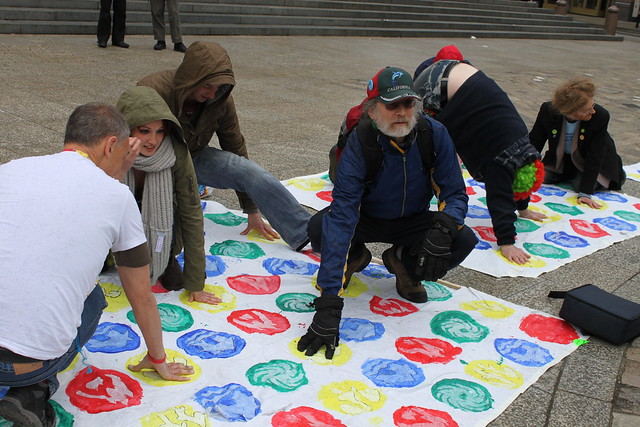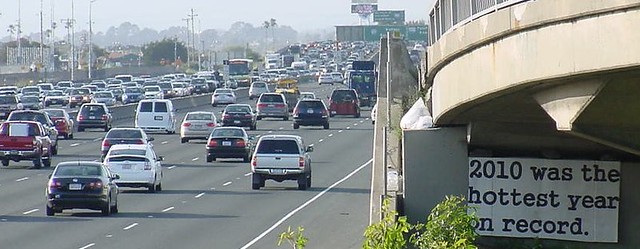That’s 600 Vermonters making a giant dot–
and in the background are flood-scarred fields, still covered with gravel and sand, from August's record floods
If they’re really planning to build a new coal port in Bellingham Washington USA, I think they better plan again

More pictures of the Ginormous Banner on the Glacier in the Sierras
Occupy London Connects the Dots by Playing Climate Twister!

Occupy London Connects the Dots by Playing Climate Twister!

Astonishing picture from tiny Midway Atoll in the Pacific
Those are Laysan albatrosses in the background and the foreground, and their downy chicks. These are one of the most magnificent species on the planet. But their nesting grounds are subject to ever more flooding

A day for guerilla billboarding
On the freeways of Los Angeles


Part of a big group en route to plant some trees near Ho Chi Minh City, Vietnam

Volunteers joined the Climate Impacts Day Vietnam in Can Gio Biosphere
Reserve in Ho Chi Minh City, where they planted trees in the park, did a
beach clean-up, and the trash they collected were made into installation
art exhibitions on the beach to convey climate change messages. They also
made a big dot with climate change photos from the national photo contest
that 350 Vietnam launched in April.
But the greatest thing is that 05/05 is only the beginning. In the coming
weeks, the Connect the Dots Vietnam campaign will continue with planting a
thousand trees along the dykes in the most flooded district in HCMC,
reinforcing the dykes and clearing up water hyacinth on the river branches
to reduce impacts, and building climate leadership skills for young people.
In this photo is a big dot made with climate change photos selected from
the photo contest named "Let's raise our voice for survival" that 350
Vietnam had launched nationwide.

From the Gyre…
 Fourteen of us are aboard the 72-foot sailboat Sea Dragon researching plastic pollution in the western accumulation zone of the North Pacific Gyre between the Majuro, Marshall Islands and Tokyo, Japan.
Fourteen of us are aboard the 72-foot sailboat Sea Dragon researching plastic pollution in the western accumulation zone of the North Pacific Gyre between the Majuro, Marshall Islands and Tokyo, Japan.
Another voyage in June 2012 from Tokyo to Honolulu will focus on identifying tsunami debris from Japan. Both voyages are lead by 5 Gyres and Agalita Marine Research Foundation and include scientists, artists, filmmakers, activists, product developers, divers, and sailors. The voyages’ research goals include conducting surface samples of plastic pollution every 50 nautical miles and identifying large marine debris objects.
Currently, we are approximately 50 miles from Bikini Atoll, one of the most northern atolls of the Marshall Islands, and have already spotted plastic debris in the ocean, including a plastic tube and plastic cup. We expect to find much more plastic pollution and possibly tsunami debris after the next 400 nautical miles, once we enter the heart of the western accumulation zone. Though less than 10% of Japan’s tsunami debris is expected to be within the western accumulation zone, southeast of Japan, we expect to find evidence of the tsunami out here that will help the world understand how large scale weather events have longterm impacts over 1000s of miles and across entire oceans.
We start research tomorrow on the 350 Day of Action!
Mirzoobod and Vahdatobod, Tajikistan

